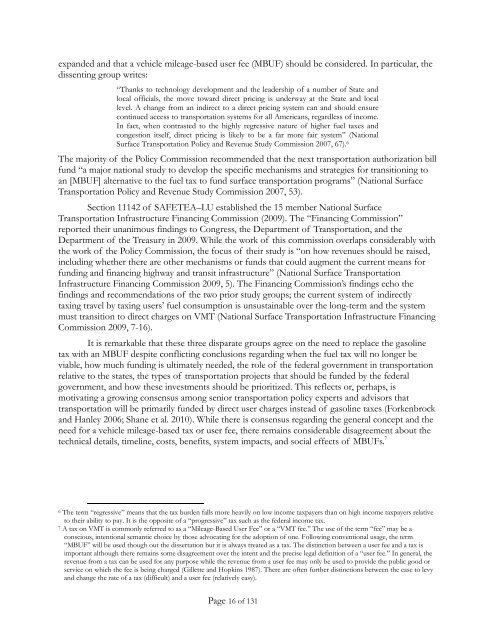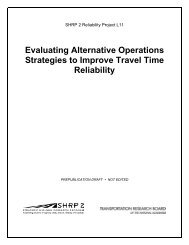Mileage-Based User Fee Winners and Losers - RAND Corporation
Mileage-Based User Fee Winners and Losers - RAND Corporation
Mileage-Based User Fee Winners and Losers - RAND Corporation
Create successful ePaper yourself
Turn your PDF publications into a flip-book with our unique Google optimized e-Paper software.
exp<strong>and</strong>ed <strong>and</strong> that a vehicle mileage-based user fee (MBUF) should be considered. In particular, the<br />
dissenting group writes:<br />
“Thanks to technology development <strong>and</strong> the leadership of a number of State <strong>and</strong><br />
local officials, the move toward direct pricing is underway at the State <strong>and</strong> local<br />
level. A change from an indirect to a direct pricing system can <strong>and</strong> should ensure<br />
continued access to transportation systems for all Americans, regardless of income.<br />
In fact, when contrasted to the highly regressive nature of higher fuel taxes <strong>and</strong><br />
congestion itself, direct pricing is likely to be a far more fair system” (National<br />
Surface Transportation Policy <strong>and</strong> Revenue Study Commission 2007, 67). 6<br />
The majority of the Policy Commission recommended that the next transportation authorization bill<br />
fund “a major national study to develop the specific mechanisms <strong>and</strong> strategies for transitioning to<br />
an [MBUF] alternative to the fuel tax to fund surface transportation programs” (National Surface<br />
Transportation Policy <strong>and</strong> Revenue Study Commission 2007, 53).<br />
Section 11142 of SAFETEA–LU established the 15 member National Surface<br />
Transportation Infrastructure Financing Commission (2009). The “Financing Commission”<br />
reported their unanimous findings to Congress, the Department of Transportation, <strong>and</strong> the<br />
Department of the Treasury in 2009. While the work of this commission overlaps considerably with<br />
the work of the Policy Commission, the focus of their study is “on how revenues should be raised,<br />
including whether there are other mechanisms or funds that could augment the current means for<br />
funding <strong>and</strong> financing highway <strong>and</strong> transit infrastructure” (National Surface Transportation<br />
Infrastructure Financing Commission 2009, 5). The Financing Commission’s findings echo the<br />
findings <strong>and</strong> recommendations of the two prior study groups; the current system of indirectly<br />
taxing travel by taxing users’ fuel consumption is unsustainable over the long-term <strong>and</strong> the system<br />
must transition to direct charges on VMT (National Surface Transportation Infrastructure Financing<br />
Commission 2009, 7-16).<br />
It is remarkable that these three disparate groups agree on the need to replace the gasoline<br />
tax with an MBUF despite conflicting conclusions regarding when the fuel tax will no longer be<br />
viable, how much funding is ultimately needed, the role of the federal government in transportation<br />
relative to the states, the types of transportation projects that should be funded by the federal<br />
government, <strong>and</strong> how these investments should be prioritized. This reflects or, perhaps, is<br />
motivating a growing consensus among senior transportation policy experts <strong>and</strong> advisors that<br />
transportation will be primarily funded by direct user charges instead of gasoline taxes (Forkenbrock<br />
<strong>and</strong> Hanley 2006; Shane et al. 2010). While there is consensus regarding the general concept <strong>and</strong> the<br />
need for a vehicle mileage-based tax or user fee, there remains considerable disagreement about the<br />
technical details, timeline, costs, benefits, system impacts, <strong>and</strong> social effects of MBUFs. 7<br />
6 The term “regressive” means that the tax burden falls more heavily on low income taxpayers than on high income taxpayers relative<br />
to their ability to pay. It is the opposite of a “progressive” tax such as the federal income tax.<br />
7 A tax on VMT is commonly referred to as a “<strong>Mileage</strong>-<strong>Based</strong> <strong>User</strong> <strong>Fee</strong>” or a “VMT fee.” The use of the term “fee” may be a<br />
conscious, intentional semantic choice by those advocating for the adoption of one. Following conventional usage, the term<br />
“MBUF” will be used though out the dissertation but it is always treated as a tax. The distinction between a user fee <strong>and</strong> a tax is<br />
important although there remains some disagreement over the intent <strong>and</strong> the precise legal definition of a “user fee.” In general, the<br />
revenue from a tax can be used for any purpose while the revenue from a user fee may only be used to provide the public good or<br />
service on which the fee is being charged (Gillette <strong>and</strong> Hopkins 1987). There are often further distinctions between the ease to levy<br />
<strong>and</strong> change the rate of a tax (difficult) <strong>and</strong> a user fee (relatively easy).<br />
Page 16 of 131















